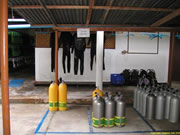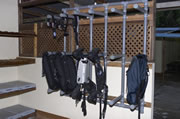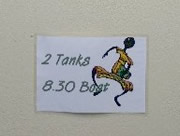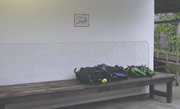![]()
![]()
![]()
Ellaidhoo Dive Centre

Sea Explorer Dive Centre, Ellaidhoo
The dive centre is very well-organised. They have spacious benches for laying out your equipment, a long trough of water for rinsing your equipment, a separate basin of water for rinsing your regulator, loads of storage space, and designated areas for everything.
After checking in at the resort and settling into your room, bring your equipment to the dive centre. The walk from your room to your dive centre shouldn't take more than 5 minutes.
Check in your dive equipment. The dive centre will make a note of your equipment, assign you a box number, and pass you the equipment that you want to rent. We brought everything of our own, but we still rented a weight belt and belts. Although our equipment is such that we don't use weight belts, we took one each anyway because they're handy to wrap your equipment up neatly.
The dive centre will then give you a brief orientation of the dive centre.
If you want to use Nitrox, you must analyse and label your own tank before every dive (see below).
You must sign up for the dives you want on a noticeboard.
You can basically leave your equipment at the dive centre throughout your stay. However, you're recommended to keep the snorkel and mask in your own room.
Although you're assigned a box which you can store all your equipment in, you won't actually use it if you go on all the scheduled dives.; This is because you must leave your equipment on a designated bench before every dive. So if you're diving in the morning dive, you leave your equipment out the night before. After the morning dive, there's no need to store your stuff in the box because you will leave it out on the Afternoon Dive bench. After the afternoon dive, you will either leave your equipment on the Night Dive bench (the dive centre does two night dives a week on Tuesdays and Fridays), or leave it on the Morning Dive bench for the next morning's dive.
The dive centre boat crew will load your stuff onto the dive boat before every dive.
When we went in July (low season), we arrived at the hotel in the morning, checked into the dive centre immediately, and signed up for the checkout dive on the same day in the afternoon. In high season, the checkout dive may be at fixed times though.
Your checkout dive will be a boat dive to the Maaga Lagoon. The instructor will brief you on the dive site, and also tell you what is expected.
During the dive itself, the instructor will lead you to a sandy patch where you will kneel on the sand and complete three skills:
1) filling and clearing of mask
2) exchanging of regulator
3) regulator recovery
After that just follow the guide and enjoy the dive. That's all there is to it.
The divemasters / instructors are wonderful. They give plenty of tips at every single dive, and always look out for you. On the day we checked into the resort, the dive centre's base leader came up to our table at lunchtime to say hello.
The boat crew are also wonderful. They do almost everything, such that the only strenuous thing you EVER have to do is put on your wetsuit.
You start your dive day by going to the dive boat. The boat crew would already have loaded your equipment on the boat and when you arrive, they will put your tank in front of you (and put in the adapter if necessary) for you to rig up to your equipment. When you're done, the boat crew will put the tank away in the rack or under the seat.
On the way to the dive site, the divemaster will brief you on the site and what to expect. (They know everything, like the colour of the resident frog fish on a particular stretch of coral.)
When you reach the dive site, the boat crew will take out your tank and help you put it on.They will hold your hand when you go to the boat's 'jump-off point'.
After your dive, before you get back onto the boat, pass your fins to the boat crew who will put them away. Then when you climb the ladder, the boat crew will hold up your tank to lighten your load. The boat crew will then hold your hand until you're safely seated. Then they help you take off your equipment. You un-rig your equipment and the boat crew puts away the tank.
The boat crew then passes you a cup of hot Earl Grey tea and wafers.
Chivalry Meter: Excellent

Neat and organised 
The drying room has a warm fan and plenty of place to hang your equipment ... 
... plus plenty of shelf space for your other stuff


Leave your equipment on the designated bench for your next dive (look for the sign showing the time of the next dive). The staff will load it onto the dive boat for you.

IMPORTANT
It is compulsory in Maldives for all divers to have a snorkel and a dive computer. If you're used to diving without a snorkel, you'll find it gets in your way and can be quite annoying.
One instructor tucked his up his wetsuit (shorty) pants and my husband tucked his behind his backplate. I tucked mine onto my backplate straps. Next time we go, we're going to get a cheapo kiddy snorkel from a mama shop. Or saw off the end of an old snorkel.

If you're diving with Nitrox, you must analyse your own tank before every dive. You simply pick one of the Nitrox tanks that are laid out neatly at the dive centre, and bring them to the Nitrox Station (don't worry, it's all within 2 m radius).
The Nitrox tanks are 10-litres or 12-litres (thereabouts). For me, the 10-litre one was enough, while for the guys, they took the 12-litre ones.
Step One: |
Step Two: |
Step Three: Label your tank with your room number, the EAN and the MOD, and the date; then carry the tank to the designated area (again, this is less than 2m from the Nitrox station so it's not like you have to lug the tank all over the place.)


Clear signage so you know where to put your Nitrox tank.

Cost of Nitrox II certification
US$117 per person for the course (including materials, theory test and 2 dives)
+
US$110 for certification fee (after completing the course)